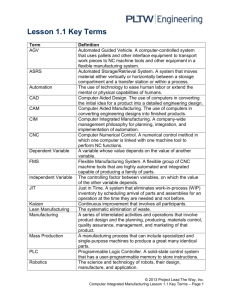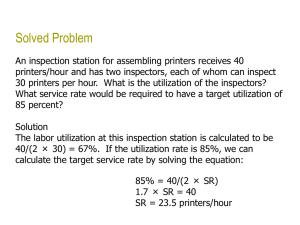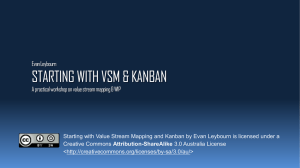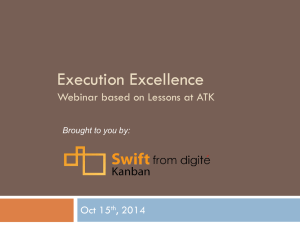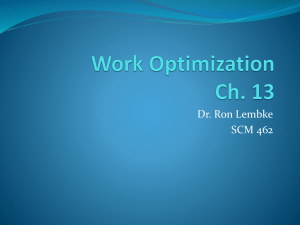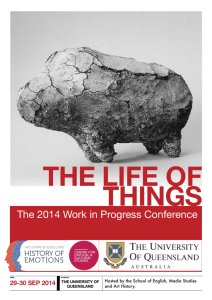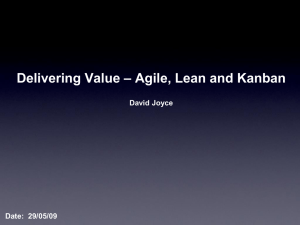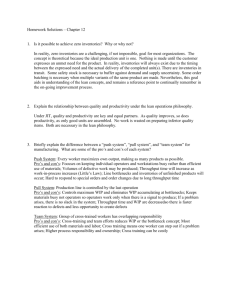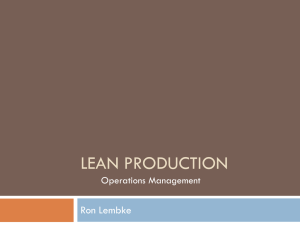Arrival Schedule - Washington State University
advertisement
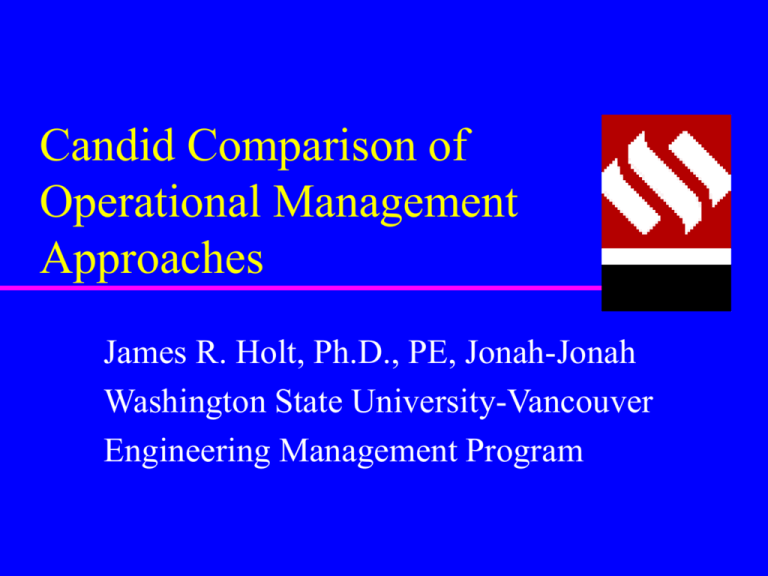
Candid Comparison of Operational Management Approaches James R. Holt, Ph.D., PE, Jonah-Jonah Washington State University-Vancouver Engineering Management Program Purpose for Presentation Understand different approaches to managing repetitive production processes Highlighting several key production measurements Comparing performance on an equal playing field Highlight consistent key variables Draw some conclusions of value The Situation Describe many different production management approaches into generally acceptable methods Create a generic simulation model and test procedure that is fair to all management approaches Provide sensitivity analysis to make fair comparisons Fairness Paramount Production process straight forward – No disassembly, no assembly, – Parallel machines accept any work – No set-ups No – – – – people or logistics problems No priority work Independent - No artificial slow downs Available material available immediately Tolerant customer that buys all immediately The Challenge Production – – – – – – – Model 10 machines of 6 types -- mostly in parallel Production times mostly balanced Double Constraint Free flow of products on any path Normal distribution on production 90% productive capacity Repetitive scheduled arrivals Production Simulation Model Raw Material Machine Type 1 Machine Type 2 Machine Type 3 Machine Type 4 Machine Type 5 Machine Type 6 1 Mean=8 SD=4 2 Mean=26 SD=8 5 Mean=19 SD=5 7 Mean=20 SD=6 9 Mean=9 SD=4 10 Mean=8 SD=4 3 Mean=28 SD=8 6 Mean=19 SD=5 8 Mean=20 SD=6 4 Mean=26 SD=8 Machines breakdown approximately 10% of the time Finished Goods Arrival Schedule 30 Product A Product B Number of Products 25 20 15 10 5 0 0 200 400 600 800 1000 1200 1400 Time-Mins 1600 1800 2000 2200 2400 Management Approaches Traditional push manufacturing Push with batch size of 10 Work cells Just-In-Time with kanban of 1 Just-In-Time with kanban of 3 Lean manufacturing Drum-buffer-rope Agile manufacturing Measurements Based on 20 Trials of 100 hrs Average work-in-process (alpha=0.02) Average flow time (in process only) Average efficiency of all machines Average produced in 100 hours Profit based on $80 per part and $30,000 operating expense per 100 hours ROI based on annualized investment ($50,000 per 100 hours) plus inventory Definition: Traditional Efficiency is very important at every work station Push materials in as soon as possible No limit on Work-In-Process (queues) Work flows first-in-first-out No priorities Transfer batch size of one View: Trad.sim Definition: Traditional Batch Optimizes the costs of efficiency and investment Lot sizes planned to optimize individual performance Lot sizes reduce set-up times Efficiencies of scale Parts moved between machines in lots of 10 Definition: Cell Production Dedicate machines to products Special treatment of products Some efficiencies possible within cells Easier to manage / control / improve processes in cells Cell draws from, connects to rest of plant View: Cell.sim Definition: Just-In-Time Pull system -- produces to demand Work-In-Process controlled (limited) Kanban card governs flow between machines (parts move only on demand) Simulation JIT1: Kanban card of 1 Simulation JIT3: Kanban card of 3 Demand is at max level of performance View: JIT1.sim Definition: Lean Manufacturing Maintain low work-in-process Maintain high efficiencies (trim excess capacity) Use push or pull approach This simulation uses a balanced line with maximum work-in-process of 5 parts per machine View: Lean.sim Definition: Drum-Buffer-Rope Drum process is slowest machine(s) Buffer protects capacity of drum -- holds adequate work-in-process to keep drum at maximum efficiency Rope restricts excess work from entering system -- limits maximum work-in-process in front of the constraint Buffer size limited to 17 parts View: Dbr.sim Definition: Agile Production Very flexible manufacturing Respond to demand, workload shifts as needed Multi-skill machines / workers to perform a variety of tasks Machines added / workers added / moved to meet high demands In this simulation, workers move if own queue is < 2 and service area average >2 View: Agile.sim Performance Measures Traditional Batch-10 WIP Cell 361 942 1055 FLOW TIME 39919 106019 92532 EFFICIENCY. 76%1 83%1 68%1 PRODUCED 4994 4364 4175 PROFIT $9920 $4880 $3360 19% 9% 6% ROI Performance Measures Traditional JIT-1 JIT-3 361 8.55 271 FLOW TIME 39919 1363 32812 EFFICIENCY. 76%1 552 60%2 PRODUCED 4994 38130 4187 PROFIT $9920 $480 $3440 19% 1% 7% WIP ROI Performance Measures Lean DBR Agile 385 191 352 FLOW TIME 37336 2217 39521 EFFICIENCY. 80%1 76%1 75%1 PRODUCED 4728 5003 5004 PROFIT $7760 $10000 $10000 15% 20% 19% WIP ROI Summary Measures Pros Cons Traditional Good Prod Mod WIP Batch (10) High Eff. High WIP, Long Flow Cell Control High WIP, Flow, Prod JIT-1 Lowest WIP Lowest Production JIT-3 Moderate Low ROI Lean High Efficiency Mod Flow DBR WIP, Flow, Prod Agile High Prod Mod Efficiency Long Flow Join WSU’s Engineering Management Program EM 526 Constraints Management EM 530 Applications in Constraints Management http://www.cea.wsu.edu/engmgt/
